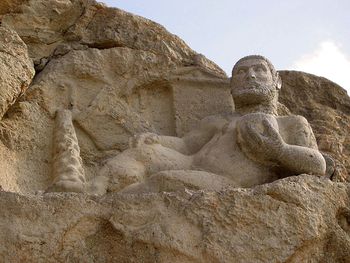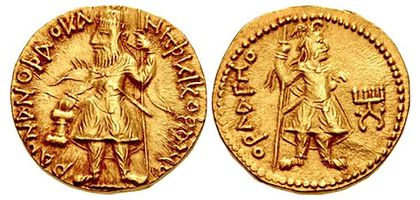「ウルスラグナ」の版間の差分
| 53行目: | 53行目: | ||
バフラムが旅人の守護神とされていたことは、ベヒストンの幹線道路にある等身大のバフラムの岩像が物語っているのかもしれない。そこでバフラムは、手にゴブレット、足元に棍棒、下にライオンの皮を敷いて寝転んでいる。 | バフラムが旅人の守護神とされていたことは、ベヒストンの幹線道路にある等身大のバフラムの岩像が物語っているのかもしれない。そこでバフラムは、手にゴブレット、足元に棍棒、下にライオンの皮を敷いて寝転んでいる。 | ||
| + | ササン朝初期には、バフラムはやはりギリシャのヘーラークレスに相当する神として表現されている。 | ||
2023年1月2日 (月) 18:20時点における版
ウルスラグナ(Vərəθraγna、Verethragna)とは、ゾロアスター教において崇拝される英雄神[3][4]。
中性名詞verethragnaは、アヴェスター語のverethra「障害」、verethragnan「勝利」に関連するものである[5]。その代表が「勝利」の神格であるヴェレストラグナであり、「勝利をもたらす神として、ヴェレストラグナは古来最高の人気を誇っていた」のである[6]。ゾロアスター教の中世ペルシャ語では、Verethragnaは𐭥𐭥𐭫𐭧𐭫𐭠𐭭となり、そこからVahram、Vehram、Bahram、Behramなどの変種が派生している。
ヴェーダ語のサンスクリット語と同義語である。ヴェーダの神インドラは、主にインドラの諡号であるvr̥tragmʰ-が名詞verethragna-に対応することから、ゾロアスター教のアヴェスタのウルスラグナに対応すると思われる。
この名前と神格は、アルメニア語のՎահգն Vahagn とՎռամ Vṙamに借用され、仏教のソグド語wšɣn w(i)šaɣn、Manichaen Parthianの𐭅𐭓𐭉𐭇𐭓𐭌 wryḥrm Wahrām, クシャンバクトリアン ορλαγνο Orlagnoに類縁関係がある[7]。ヴィシュヌ、マニ教のアダマス、カルデア/バビロニアのネルガル、エジプトのホルス、ヘレニズムのアレース、ヘーラークレースなど、ヴィシュヌの姿は非常に複雑だが、その類似性も指摘されている。
目次
概要
ウルスラグナの名は勝利を意味し、アヴェスター語形で、パフラヴィー語ではワルフラーン(Varhrān)といい、「障害を打ち破る者」を意味する。他の別名にアルタグン、ワフラームやバフラームがある。 語源的にインド神話の神インドラの形容語ヴリトラハンと共通しており[8]、ウルスラグナの成立に関しては、イランでインドラが悪魔の地位に降ろされた結果、形容語だけが独立した神格として崇拝され続けたという説と、イランに存在したウルスラグナの原型となる神とインドラがヴェーダが成立する際に合体したという説がある[8]。
ゾロアスター教神学に於いては中級神ヤザタに分類される。男性神格としてイメージされ、特に戦争の勝利を司る神で、虚偽者や邪悪なる者に罰を与え自らを崇拝するものには勝利を与えるという。 戦う両軍の間に四枚の翼を広げてウルスラグナが降り立った時は、最初にこの神を崇めた方が勝利をおさめるといわれる。 またペルシア7曜神では火星神とされる。
教祖ゾロアスター自身が説いたとされる『ガーサー』には、ウルスラグナは特定の神格としては登場していない。ヘレニズム色の強いパルティア王国の時代になると、ギリシア神話のヘーラクレースと同一視され盛んに信仰された[8]。
サーサーン朝ペルシアでは帝王の性格を持つ戦勝の神として熱心に崇拝され、バフラームの名を持つ王も数名現れている[8]。その初代皇帝アルダシール1世は、自らウルスラグナの聖火を建立し、以後、サーサーン歴代の皇帝達が参詣した。また、この時代から現在に至るまでウルスラグナは道路や旅程を守る神として信仰されている[8]。
アルメニアの民族的英雄神ヴァハグン(Vahagn)はウルスラグナが起源で、怪物ヴィシャップを殺す。
聖典の中で
バフラム・ヤシュトの中で
ウルスラグナへの賛美歌であるヤシュト14は、「保存状態は悪いが、非常に古風な要素を含んでいる」とされる[9]。そこでは、ウルスラグナは「最も高度な武装」(ヤシュト14.1)、「力ある最高の装備」(同13)、「発泡性の栄光」(同3)、「征服する優位性」(同64)を持ち、人間やデーモンと絶えず戦っている(同4、同62)と描写される。ヤシュトは、神性が現れる10の形態を列挙することから始まる。その内訳は、疾風(14.2-5)、武装した戦士(14.27)、15歳の青年(14.17)、残りの7つは動物であり、金の角を持つ雄牛(14. 7)、耳と口が金の白馬(14.9)、発情期のラクダ(14.11-13)、イノシシ(14.15)、猛禽類(veregna, 14.19-21) 、ラム(14.23)、野ヤギ(14.25)である。これらの化身の多くは他の神々とも共通し、例えば、若者、雄牛、馬もティシュトリヤ(Tishtrya)のものとされる。同様に、鳥、ラクダ、風は、武力的勝利を連想させるゾロアスター教のパンテオンのもう一人のメンバーであるヴァーユ・ヴァータ(Vayu-Vata)と共通している。
他のテキストでは
ウルスラグナは、チェスターとともに、ミスラの主要な仲間である(Mihr Yasht 10.70)。バフラム・ヤシュトのいくつかの部分は、他の神々に捧げられた讃美歌にも登場するが、それらの部分がどの方面から写されたかを特定することはほとんど不可能である。
ヤシュト14章に登場するウルスラグナがイノシシであることから、イリヤ・ガーシェヴィッチは、アヴェスター語のミスラ讃歌に登場するイノシシ、ダームイシュ・ウパマナをウルスラグナの分身と見立てた[10]。
文化・伝統の中で
ゾロアスター教のヒエラルキーにおいて
ゾロアスター教の神格構成において、バフラムは光明を司るアムシャ・スプンタのアーシャ・ヴァヒシュタ(アヴェスター語、中ペルシア語ではアルドヴァヒシュタ)を補佐する存在であり、バフラムはこのアーシャ・ヴァヒシュタを補佐する。 アケメネス朝時代後期(紀元前648〜330年)に制定されたゾロアスター教の暦では、月の20日はバフラムに捧げられている(Siroza 1.20)。
中世ペルシャの文献では、バフラムはアムシャ・スプンタの一人として特に崇められ、アンラ・マンユを追い返すのに成功したことで事実上の高位を与えられている[11][12]。
惑星の名前として
ササン朝(224-651CE)の天文・暦学改革では、火星はバフラムと名付けられた。ゼーナーは、バビロニアのネルガルは戦争の神であり、赤い惑星の名前でもあるというカルデアの星神学体系と習合的なな影響を受けていると考えている[13]。
火の階級の名において
ボイスによれば、最も神聖なクラスの火の名前として現在使われている「アタッシュ・ベーラム(Atash-Behram)」という表現は、形容詞の「勝利の火(Victorious Fire)」と「バフラムの火(Fire of Bahram)」が混同されたものだという[14]。前者はカバ・イ・ザルドゥシュトのカルティール碑文など中世ペルシャの碑文に見られる方法で、後者は現在アタッシュ・ベラムという言葉で理解されているものである。グノーリは、「イスラム時代にはゾロアスター教の司祭の教えが徐々に衰退し、自然な誤解が生じた。」と分析している[15]。
美術・図像学において
カルマニア人が勝利の神(Geographika, 15.2.14)を崇拝していたという唯一の証拠は、1世紀のストラボの記述に現れている(おそらくネアルコスによる)。ストラボが言うように、バフラム/ヴェレストラグナが彼らの「唯一の神」であったとすれば、これがバフラム/ヴェレストラグナである可能性は低い要出典、April 2015。しかし、この記述から、イラン高原以外の人々にも戦争の神々が知られていたことがわかる。その証拠に、ヘロドトス(4.59.62)にもその記述がある。
セレウコス朝(前330-150)とアルサス朝(前250-226)の時代、つまりヘレニズム文化の影響を受けた帝国では、ウルスラグナはアーレースと同一視され、ヘーラークレースと結び付けられ、ギリシャ語でアルタグネス(Artagnes)と名づけられた[16]。このような習合は彫像や図像によく現れており、特にコンマゲネのアンティオコス1世テオスの碑文には、3つの名前が一緒に出てくる。
バフラムが旅人の守護神とされていたことは、ベヒストンの幹線道路にある等身大のバフラムの岩像が物語っているのかもしれない。そこでバフラムは、手にゴブレット、足元に棍棒、下にライオンの皮を敷いて寝転んでいる。
ササン朝初期には、バフラムはやはりギリシャのヘーラークレスに相当する神として表現されている。
In the early Sasanian period Bahram is still represented as the Greek Heracles. In the relief of Ardeshir I at Naqs-e Rajab III,テンプレート:Citation needed Bahram appears as one of the two smaller figures between Ahura Mazda and the king. There, he has a lion's skin in his left hand and brandishes a club in his right. The other small figure – who appears to be paying homage to Bahram – is the future king Bahram I.
Bahram also appears as wings, or as a bird of prey, in the crowns of the Sasanian kings. This iconography first appears in the crown of Bahram II which also bears the name of the divinity. A similar image is adopted by Peroz (whose name also means 'victorious') as well as by Khosrau Parwez (again, Parwez meaning 'ever-victorious'). Similarly, boar and eagle heads on caps crown the heads of princes. Boar figures are widespread in Sasanian art, appearing in everything from textiles to stucco and in silver ornaments, coins, and seals. Other animal motifs have been found that recall the aspects of Bahram (see the ten forms of Bahram in the Avesta, above). The bird motif on Sasanian-era fire altars are also believed to represent Bahram.
As the name of kings
Bahram was the name of six Sasanian kings:
- Bahram I, r. 271–274. Son and successor of Shapur I
- Bahram II, r. 274–293. Son and successor of Bahram I
- Bahram III, r. 293. Son and successor of Bahram II
- Bahram IV, r. 388–399. Son and successor of Shapur III
- Bahram V, r. 420–438. Son and successor of Yazdegerd I
- Bahram Chobin, r. 590 - 591. Successor of Hormizd IV
In Avestan scholarship
The interpretation of the divinity was once one of the more widely debated fields in Zoroastrian scholarship since the theories of origin reflected a radical revolution in ethical, moral and religious values.テンプレート:Sfn
Primarily because the Avestan adjective verethragnan ('victorious') had a corresponding Vedic term vrtrahan where it appeared "preponderantly [as] a qualification of Indra", Zoroastrians and Hindus accept that テンプレート:Sfnテンプレート:Page needed in Indo-Iranian times there existed the warrior god Indra and that Avestan Verethragna might be analogous to that divine figure. The Sanskrit cognate of Verethragna is Vritraghna, which is an epithet for Indra in Vedic literature, and he too is the destroyer of "Vritra", an Asura whose name literally means obstacle.
But western scholars oppose this identification. In the Avesta, it is the hero warrior-priest Fereydun who battles the serpent Aži Dahāka (which, for the virtue of 'Azi' being cognate with Sanskrit 'Ahi', snake, is – by proponents of the theory - associated with Vedic Vritra). One Western scholar claims that, in the Vedas, the epithet 'hero' (sura) is itself almost exclusively reserved for Indra, while in the Avesta it is applied to Thraetaona and other non-divine figures. The term "victorious" is not restricted to Verethragna, but is also a property of a number of other figures, both divine and mortal, including Thraetaona. Then, while in the Vedas it is Indra who discovers Soma, in the Avesta, it is humans who first press Haoma and Thraetaona is attributed with being the "inventor of medicine". In the Vedas, Indra strikes with vajra, but in the Avesta vazra is Mithra's weapon.
Attempts to resolve these objections led to the development of another theory, in which, in addition to the pre-historical divinity of victory, there was also a dragon-slaying hero Indra. Then, while the Iranians retained the figures independently of one another, the Indians conflated the two (leaving an echo in the character of Trita Aptya).
This theory too had its problems, in particular the fact that Indra was already evidently a divine figure, and not a man, in the Mittani treaties, where he appears in the company of Mitra and Varuna. That again raises more questions since the treaties echo the Rig Veda's invocation of all three as protectors of contract, again, not a property associated with Verethragna.
However, as Benveniste and Renou demonstrated, many of the objections to the first theory could be negated if the evidence were reviewed in light of the fact that the principal feature of Verethragna was not to slay noxious creatures but to overcome obstacles (verethra), in particular to unblock the flow of apas, the waters, the holiest of the elements.テンプレート:Sfn
Paul Thieme agreed with this principal feature, but clarified that while the wealth of archaic elements in the Bahram Yasht clearly point to the pre-Zoroastrian era, the interpretation of proper names is "highly conjectural", and "in no case do we get a decisive argument against their Indo-Aryan or old Indic character"テンプレート:Sfn Adopting "the exact linguistic and exegetic analysis" of Benveniste and Renou, Thieme concludes "Proto-Aryan *Indra has assumed the functions of a Proto-Aryan god *Vrtraghna." Noting that Vrtrahan is the name of Indra only in the later Sanskrit texts (but not in the Rig Veda), Thieme adds "there is no valid justification for supposing that the Proto-Aryan adjective *vrtraghan was specifically connected with *Indra or any other particular god."テンプレート:Sfn
See also
Bibliography
- テンプレート:Citation
- テンプレート:Citation
- テンプレート:Citation
- テンプレート:Citation
- テンプレート:Citation
- テンプレート:Citation
- テンプレート:Cite encyclopedia
- テンプレート:Citation
- テンプレート:Citation
- テンプレート:Cite book
- テンプレート:Citation
10の化身
『ウルスラグナ祭儀書』によれば、ウルスラグナはアワタールという変身に長け、10種の姿をとってゾロアスターの前に現れたとされる。
それによりウルスラグナは変身して戦うといわれ、特に力強いイノシシの姿をとって戦場でミスラを先導する姿は、宗教画などに好んで描かれた。
また、鳳(おおとり)の時は霊力に優れ、この羽根を持てば災難除けの呪いになった。この羽根を身体に擦り付けると、悪い呪いを術者に跳ね返す事が出来るといわれる。
- 強い風
- 黄金の角を持つ雄牛
- 黄金の飾りをつけた白馬
- 鋭い爪と長い毛を持つ俊足の駱駝
- 鋭い牙をした野猪
- 十五歳の輝かしい若者
- 鳳(おおとり)
- 美しい野生の雄羊
- 鋭い角を持つ山羊
- 黄金の刃のある剣を持つ人間
これはヴィシュヌの10のアヴァターラに対応するという説がある[18]。 両者の変化する動物には猪を除いて共通するものが無いが、ゾロアスター教では善悪二元論によって善い動物・悪い動物が規定されていることと、ウルスラグナの成立にオリエント文化の影響があったことなどが背景として考えられる[8]。
私的考察
ウスラグナは北欧神話のヴァルハラと関連するのではないか。また子音構成からいってオーディンと同起源の神かと思う。
参考文献
- Wikipedia:ウルスラグナ(最終閲覧日:22-12-15)
- イヴ・ボンヌフォワ編, 金光仁三郎主幹、安藤俊次ほか共訳, 世界神話大事典, 大修館書店, 2001-03, isbn:978-4-469-01265-1
関連項目
- アレース(スキタイ)
- ヴァジュラバーニ
参照
- ↑ Visscher Marijn S., Beyond Alexandria: Literature and Empire in the Seleucid World, 2020, Oxford University Press, isbn:978-0-19-005908-8, page75, note 26, https://books.google.com/books?id=4yntDwAAQBAJ&pg=PA75
- ↑ Gnoli, Jamzadeh, 1988, pp510–514
- ↑ Sara Kuehn, The Dragon in Medieval East Christian and Islamic Art: With a Foreword by Robert Hillenbrand, https://books.google.com/books?id=AZWgdBCgmLYC, 12 July 2011, BRILL, isbn:978-90-04-18663-7, page103
- ↑ Bert G. Fragner, Proceedings of the Second European Conference of Iranian Studies: Held in Bamberg, 30th September to 4th October 1991, by the Societas Iranologica Europaea, https://books.google.com/books?id=-y46AQAAMAAJ, 1995, Istituto italiano per il Medio ed Estremo Oriente
- ↑ Gnoli, 1989, p510
- ↑ Boyce, 1975, p63
- ↑ Orlagno, British Museum, https://www.britishmuseum.org/collection/term/BIOG132106, www.britishmuseum.org
- ↑ 8.0 8.1 8.2 8.3 8.4 8.5 岡田明憲、松枝到(編)「古代イランの動物変身」『象徴図像研究:動物と象徴』 言叢社 2006 ISBN 4862090079 pp.101-114.
- ↑ Boyce, 1975, p63
- ↑ Gershevitch, 1959, pp166–169; pro Gnoli, 1989, p511; contra Boyce, 1975, p. 83, n. 416
- ↑ de Menasce, 1948, p5-18
- ↑ Gnoli, 1989, p513
- ↑ Zaehner, 1955, p147
- ↑ Boyce, 1982, p222
- ↑ Gnoli, 1989, p512
- ↑ Duchesne-Guillemin, 1984
- ↑ テンプレート:Cite book
- ↑ 『世界神話大事典』(要ページ番号、2015-11-03)


